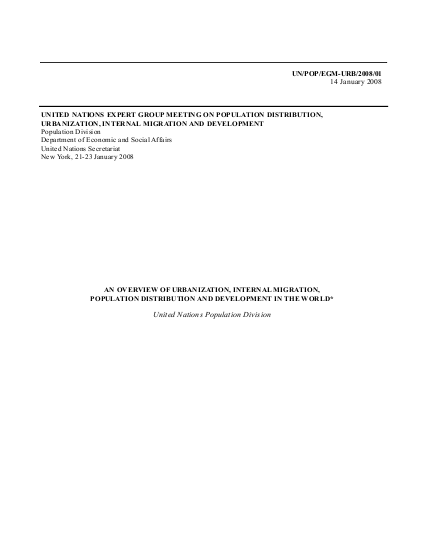
The distribution of humanity on the earth’s surface has always responded to the opportunities that different territories provide. After the invention of agriculture, the availability of arable land largely determined the place where most people settled. The practice of agriculture also permitted the accumulation of food surpluses and the differentiation of productive activities that led to the emergence of more complex settlements generically identified as “cities”. In modern history, cities have played key roles as centres of Government, production, trade, knowledge, innovation and rising productivity. The changes brought about by the industrial revolution would be unimaginable in the absence of cities. The mechanization of production made necessary the concentration of population. Rapid industrialization was accompanied by increasing urbanization. In 1920, the more developed regions, being the most industrialized, had just under 30 per cent of their population in urban areas. As industrialization advanced in the developing world so did urbanization, particularly in Latin America where 41 per cent of the population was urban by 1950. In Africa and Asia levels of urbanization remained lower, although the urban population increased markedly, particularly in Asia. Between 1920 and 2007, the world’s urban population increased from about 270 million to 3.3 billion, with 1.5 billion urban dwellers added to Asia, 750 million to the more developed regions, just under 450 million to Latin America and the Caribbean, and just over 350 million to Africa. These changes foreshadow those to come. Between 2007 and 2050, the urban population is expected to increase as much as it did since 1920, that is, 3.1 billion additional urban dwellers are expected by 2050, including 1.8 billion in Asia and 0.9 billion in Africa. These powerful trends will shape and in turn be shaped by economic and social development.
Urbanization has been driven by the concentration of investment and employment opportunities in urban areas as well as by the transition from lowproductivity agriculture to more productive mechanized agriculture that has produced labour surpluses in rural areas. Productive activities in industry and services cluster in cities. By one estimate, 80 per cent of the world’s GDP is generated by urban areas. As cities attract businesses and jobs, they become magnets for migrants seeking better opportunities and they congregate both the human and the entrepreneurial resources to generate new ideas, innovate and use technology in increasingly productive ways. In OECD countries, for instance, 81 per cent of patents are filed by applicants residing in urban regions (OECD, 2006a). Cities also facilitate social change, particularly through the educational and cultural opportunities they provide. Thus, in virtually every country, the transition to lower fertility started and has advanced further in urban areas.
Resource collections
- UN Habitat - Urban Response Collection
- Urban Response - Urban Crisis Preparedness and Risk Reduction
- Urban Response Collection - Community Engagement and Social Cohesion
- Urban Response Collection - Economic Recovery
- Urban Response Collection - Environment and Climate Change
- Urban Response Collection - Housing, Land and Property
- Urban Response Collection - Urban Crisis Response, Recovery and Reconstruction
- Urban Response Collection - Urban Resilience